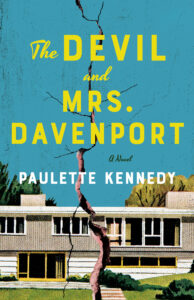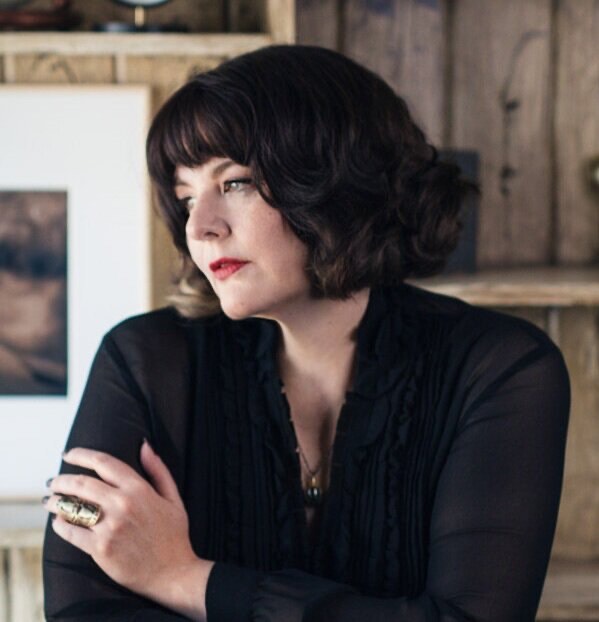Welcome Paulette! We’re excited to talk to you today about your latest relase THE DEVIL AND MRS. DAVENPORT. First, what inspired you to start writing novels and what did your journey to publication look like?
I’ve been writing since childhood–but I really only became serious about pursuing writing with a mind toward publication in my early twenties. I began going to conferences and seeking out critique. It was a bumpy road, and I had a lot to learn! I had a series of false starts and didn’t complete a novel-length manuscript until I was in my forties. That manuscript eventually became Parting the Veil and landed me my wonderful agent. I have had so many people on my journey who helped to support and encourage me: mentors in the industry and fellow authors. I wouldn’t be where I am today without them!
What inspired you to write THE DEVIL AND MRS. DAVENPORT?
The idea for The Devil and Mrs. Davenport came to me out of nowhere. Ideas like that are rare, but when they happen, it’s the kind of inspiration that has me rushing to my journals to start brainstorming immediately. I was literally putting away groceries when the title came to me! I chased the thread and began asking myself questions about this mysterious Mrs. Davenport–who she was? What was important to her? And who is the real “devil” in this story? Loretta Davenport herself was inspired by my mother and my grandmother–who were both homemakers–and my own journey as a woman living in a patriarchal society.
What about gothic fiction in general and modern feminist gothic fiction specifically appeals to you as a writer?
Gothic fiction has always served as a ready vehicle for social and political commentary in the guise of atmospheric horror. I feel passionately about many social issues, and gothic fiction gives me the opportunity to examine these themes and issues in an entertaining way. It’s also a genre that has appealing aesthetics, romance, and a touch of suspense and the supernatural, which provides the potential to reach a wide variety of readers.
Who is your favorite character in gothic fiction?
Merricat Blackwood from We Have Always Lived in the Castle. I love all of Shirley Jackson’s characters, but Merricat has my heart because she is such a phenomenally sympathetic anti-heroine.
What are some recurring themes in your work?
Grief, loss, family dynamics, mental health, feminism, and LGBTQIA+ concerns. Trains seem to be a bit of a leitmotif in my work–my characters are often moving from one place to another, both internally and externally, and I frequently use trains to get them there! Train travel represents symbolic transition well–plus it’s a romantic mode of travel with opportunity for intrigue.
How do you approach the research process for your books? Did you learn anything that surprised you when researching THE DEVIL AND MRS. DAVENPORT? Initially, when I begin outlining and drafting, I like to get a broad overview of the project and the era in which it takes place. As I continue, I will research more in-depth at the line level. I look at things like word etymology, historical details, etc while continuing to read as much as I can about my subject as I draft. I wasn’t able to travel for research for my first novel, because we were in the midst of lockdown, but travel is usually a big part of my research as well. The thing that surprised me most when researching The Devil and Mrs. Davenport was how few rights women had, even in the 1950s! We had the vote, and we had more independence in some ways, but nothing that we now take for granted in our modern era–like the ability to apply for a line of credit or a mortgage, or even seek a divorce unless we could prove “fault” on the part of our spouse. Many of these rights did not become widely available to women until the 1970s, and for women of color, basic human rights were infringed upon even more.
What period of history particularly inspires or interests you?
All of them! I have trouble sticking to one era, but the interbellum (specifically the 1920s and early 1930s) and post-WW2 periods interest me most of all. There are so many great WW1 and WW2 novels out there, and while I’ll never say never to writing one, I think it might be difficult to find new ground to cover.
What is the main message you hope readers will gain from this novel?
The biggest message I want to convey is that it’s never too late to find out who you really are and to honor yourself and love yourself without shame so you can better care for those who are important to you. Mental health representation is very important to me, and I hope that readers who cope with depression and mental illness, as I do, will feel seen with this book.
What advice do you have for new writers?
Read. Read everything you can. As often as you can. And take breaks from writing when you need to. You truly cannot draw from an empty well.
You write in the Author’s Note for THE DEVIL AND MRS. DAVENPORT that the novel is an homage to homemakers. Explain why you focused on housewives from the 1950s.
The 1950s were a time of transition for women. The war had ended, and men were coming home. There was this expectation that everything would go back to how it was before the war. Even though many women left their war-time jobs and returned to being homemakers and starting their families, a yearning for more had taken hold during the war, when women were called upon to work outside the home, voluntarily serve in the military, and assist in support services like the Red Cross. They relied on one another, saw that they could be independent and ambitious, and were given a taste of the freedom men had enjoyed for centuries. As these women birthed the Baby Boomers and returned to a life of domesticity, that restless ennui and yearning slowly festered beneath the surface and culminated in the feminist wave of the 60s and 70s. On a personal note, I think homemakers have often gotten short shrift within the feminist movement. It takes a lot of effort to run a household and take care of children. Women like my mother and grandmother had a selfless, often thankless 24-7 job that was rewarding in many ways, but not easy. After the women’s rights movement took off, women who chose to (or had to) stay at home with their children and could not work outside the home were often denigrated and shamed. I’ve since learned that this kind of thinking is bad feminism, and I have also learned from experience that being a stay-at-home parent is not the easiest path! So, this is my love letter to the homemakers of the past, and present. You can still be a feminist in an apron.
Thank you for joining us today, Paulette. Readers, here’s a quick look at THE DEVIL AND MRS. DAVENPORT:::
 The first day of autumn brought the fever, and with the fever came the voices.
The first day of autumn brought the fever, and with the fever came the voices.
Missouri, 1955. Loretta Davenport has led an isolated life as a young mother and a wife to Pete, an ambitious assistant professor at a Bible college. They’re the picture of domestic tranquility―until a local girl is murdered and Loretta begins receiving messages from beyond. Pete dismisses them as delusions of a fevered female imagination. Loretta knows they’re real―and frightening.
Defying Pete’s demands, Loretta finds an encouraging supporter in parapsychologist Dr. Curtis Hansen. He sees a woman with a rare gift, more blessing than curse. With Dr. Hansen’s help, Loretta’s life opens up to an empowering new purpose. But for Pete, the God-fearing image he’s worked so hard to cultivate is under threat. No longer in control of his dutiful wife, he sees the Devil at work.
As Loretta’s powers grow stronger and the pleading spirits beckon, Pete is determined to deliver his wife from evil. To solve the mysteries of the dead, Loretta must first save herself.






